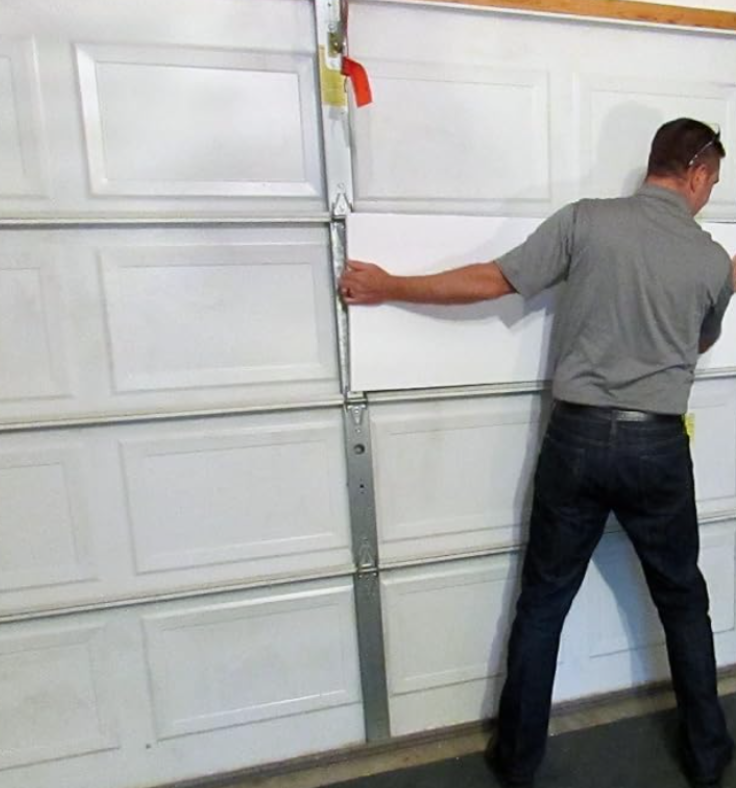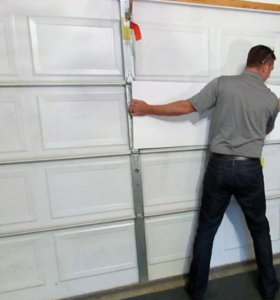Most garage doors on new construction builds will be insulated. The most common reasons a garage door may NOT be insulated is because of the added cost, mild climate or because the garage is detached (making the insulation non essential because it won’t directly affect heat loss/gain in the home or be used as work space).
If you ended up with an attached garage with a door lacking insulation, you may be finding it rather inconvenient. For instance, it may be too cold to work on projects or home energy bills may be higher than desired.
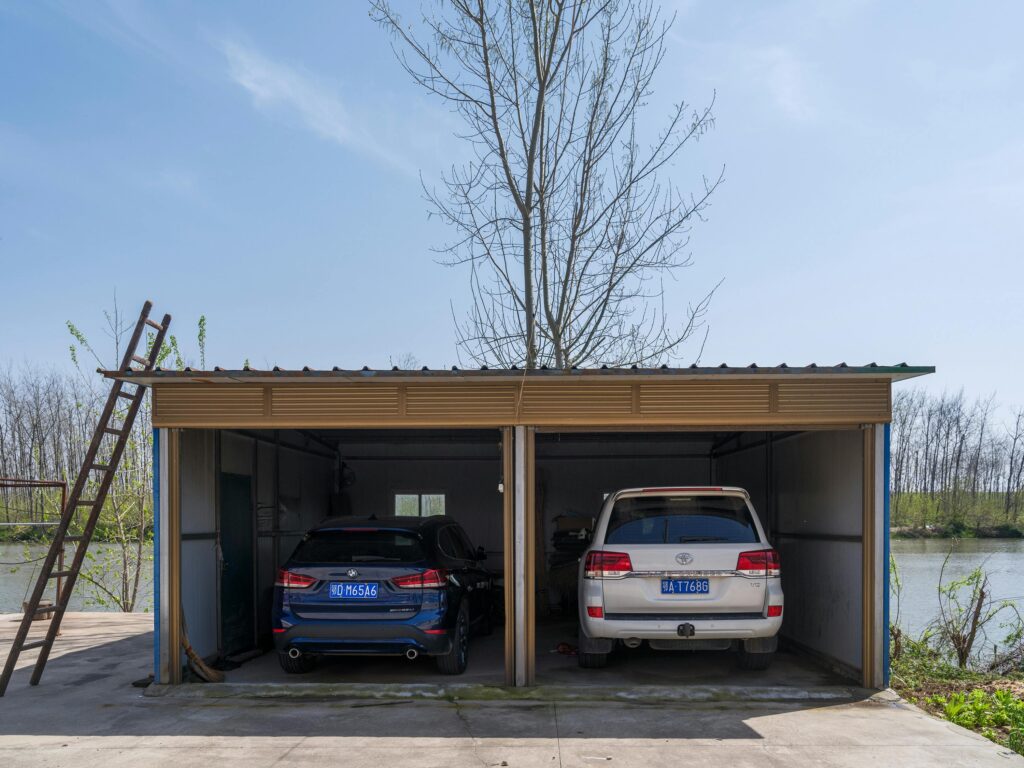
If you are in this situation you may be considering DIY-ing your garage door insulation project.
This blog will dive into garage kits, panels, installation and costs.
Read on to see what options are available to you.
Can You Add Insulation To Garage Door?
Yes. You can absolutely add insulation to an existing garage door. It’s a cost-effective way to improve your home’s energy efficiency and create a space that is usable in all seasons. There are many different options for doing so and we will jump into those throughout this blog.
How Does Garage Door Insulation Work?
Garage door insulation helps to reduce the transfer of heat through the door allowing for better energy efficiency and a more comfortable space. Materials such as foam boards, polyurethane, or other reflective barriers are typically used to create a buffer that keeps outdoor air outside and indoor air inside.
This is particularly helpful in the winter months to keep cold air outside and warm air inside the garage. Besides just air leakage through the garage door, heat can actually leak from the home into the cold garage adding extra strain on the heating system.
The opposite is true in the summer months. Hot air can be transferred from outside through the garage door and into your garage space. The warm air can then move into the home raising indoor temperatures.
Achieving a stable temperature within the garage is critical for energy efficiency. Insulation is also beneficial if the garage is going to be used as a home gym or work space.
If you are wondering if there is significant heat loss occurring in your garage, attic or in other areas of your home, consider contacting a professional for a heat loss inspection. A professional may utilize thermal cameras and other specialized equipment to identify problem areas. Some structural engineering companies, such as Complete Building Solutions, perform these kinds of inspections, but not all structural engineers offer the same services.
Note- One clear sign of heat loss in your garage is ice dams or frost (this goes for heat loss in your attic as well).
Get a free quote on your project!
Ready to start your project? Reach out to Complete Building solutions and get a quote absolutely free.
Are Garage Door Insulation Kits Worth It?
We know one thing for sure, insulating your garage door will never be a bad idea. So, is a kit worth it?
It could be exactly what your garage needs depending upon the goals of the project and budget.
Questions to ask yourself:
- What kind of R-value are you looking to achieve: For very cold climates you may want to aim for R7. In areas with milder winters, R5 may be just enough. Keep in mind that pre insulated garage doors will have much higher R-values (think R15). The kit you choose should have an R-value to match your climates needs.
- What size garage door do I have and will a kit fit this size: The first thing you need to do is measure your door. Standard 2-car garage doors measure 16’x7’. Will your desired kit fit this size?
- What is my budget: Most DIY kits are around $150-$200. Does this work with your budget?
Once you have these questions figured out, you may be wondering if the DIY Kit is worth it or if you should just DIY the garage door insulation without the kit.
Let’s talk pros and cons:
DIY Garage Door Insulation Kit-
Source – Above is an example of a garage door insulation kit that can be purchased. This particular one is from Amazon, but they can also be purchased through home improvement stores such as Home Depot and Lowes.
Pros: Easy installation, ALL materials needed to install the insulation come with the kit. You should not need to purchase any extra tools or materials. However, read the kit reviews (especially if it’s from Amazon) because homeowners may provide feedback such as if the adhesive provided was insufficient for securing the insulation to the door.
Cons: You will pay a bit more for this option versus just doing it yourself. If you have a non-standard garage door size, the kit may not work.
DIY Garage Door Insulation WITHOUT Kit-
Pros: Cheaper material costs, customization options.
Cons: Can potentially take more time since you need to purchase individual materials/tools, measure your own pieces, cut and install.
So, what do you think? Is a garage door insulation kit worth it? If you want ease of installation and have a standard size garage door, we think it is.
If you have a non-standard garage door and are fairly handy, it may be worth it for you to go solo.
Let’s talk about garage door insulation kit options below.
What Is The Best Garage Door Insulation Kit?
You will need to determine which type of insulation will be best for your project. We are going to provide you with various options below.
However, being from Minnesota, we are partial to a few insulation materials. These would be professional grade spray foam (we suggest you hire this out) and rigid board (more doable as a DIY). Hands down, these are going to be the best thermal break you can get for the cold weather.
Not everyone in the country will be dealing with the massive temperature swings we are here, so we will mention a few other kits with less R-value and cheaper price points.
Let’s dive in.
1. Reach Barrier 3009 Garage Door Insulation Kit
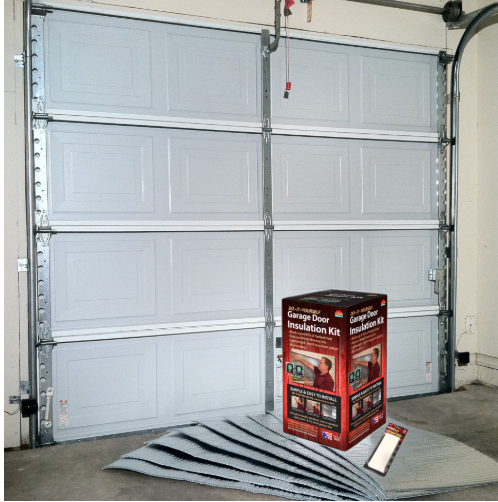
- Type: Reflective aluminum with laminated bubble layer.
- R-Value: 3-5
- Size: 8 panels (4 feet by 2 feet).
- Benefits: Easy installation, improved comfort.
- Ideal For: Moderate cold climates.
- Customer Feedback: Easy to install, effective in temperature regulation.
2. US Energy Products Double Bubble Reflective Foil
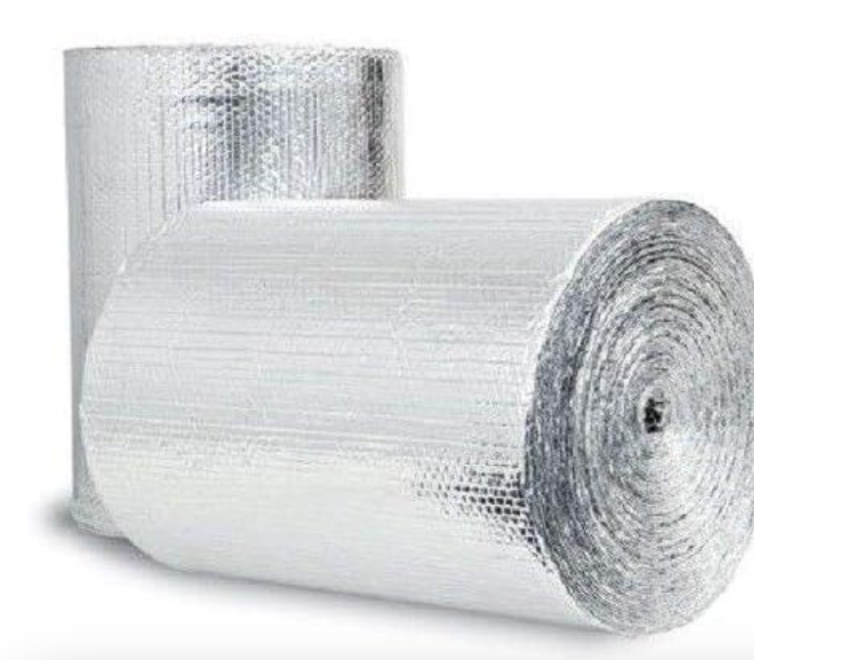
- Type: Reflective aluminum polyester with two layers of air bubbles.
- R-Value: 3 “ish”
- Size: Customizable, can be cut to fit any size.
- Benefits: Lightweight, cost-effective.
- Ideal For: Moderate to cold climates.
- Customer Feedback: Affordable, reduces heat transfer effectively.
3. US Energy Products Nasatek 2-Car Foam Insulation Kit
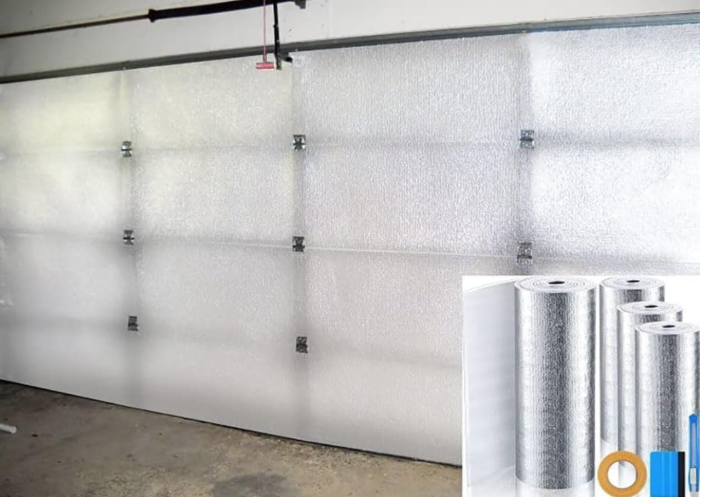
- Type: Foam core insulation with decent R-value.
- R-Value: 3.5- 4.5
- Size: 4 rolls (18 feet by 2 feet), for two-car garage doors.
- Benefits: Easy installation, durable.
- Ideal For: Cold climates with large temperature swings.
- Customer Feedback: Excellent at maintaining temperature.
4. Matador Garage Door Insulation Kit
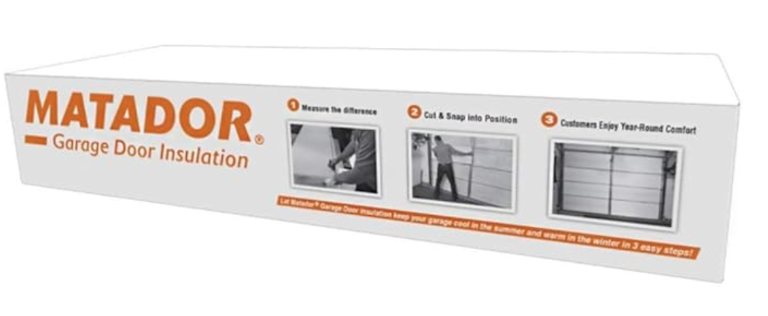
- Type: Rigid foam insulation panels.
- R-Value: Around 5-6
- Size: 8 panels (54 inches by 20.25 inches).
- Benefits: Easy to install, affordable.
- Ideal For: Cold weather with significant temperature changes.
- Customer Feedback: Great thermal performance, simple installation.
5. Froth-Pak 620 Spray Foam Insulation Kit
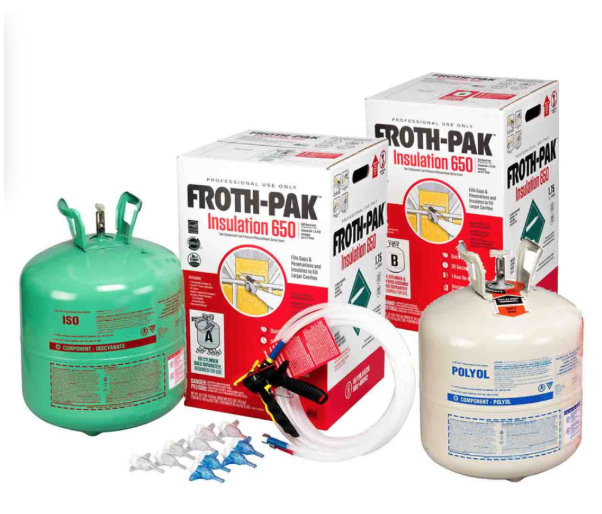
**Special mention on this one** This kit is professional grade spray foam that can come with some learning curves for the DIY person. It is one of the better kits because it provides that R-value of 6.5+ per square inch at a reasonable price. We felt we had to include it because spray foam (not to be confused with Great Stuff or similar products) offers a phenomenal R- value and thermal resistance. However, you may want to consider hiring this one out which could cost you $1.50 to $3.00 per square foot. Be sure to consider whether your door/springs are structurally able to support the additional weight from spray foam (typically they can handle it). If you’re unsure, you can consult a professional to evaluate whether any reinforcement is needed or if your existing springs and track system are sufficient for the additional weight.
- Type: Closed-cell polyurethane spray foam.
- R-Value: 6.5-7
- Size: Covers up to 620 board feet.
- Benefits: Expands to fill gaps, great for larger spaces and comprehensive insulation.
- Ideal For: Extremely cold climates with temperature extremes.
- Customer Feedback: Excellent insulation performance, but requires careful application and protective gear.
Are Garage Door Insulation Panels Worth It?
At the end of the day, you are better off to buy a garage door that is insulated. The R-value you will get from a pre-insulated garage door (think R15) far surpasses the R-value obtained by adding insulation after the fact (think R7 ish at best).
However, any insulation is better than none. Creating a thermal barrier will help to keep outside air outside and inside air inside. That is the key to creating a stable interior temperature and also important to prevent heat loss.
Walls in a home can typically obtain an R-value of 24 because they are 6 inches thick. At best, a garage door may have an R-value of 15 because you simply don’t have the added space that a wall has to pack more insulation.
Because you will have areas where an R24 (wall) meets an R15 (pre insulated garage door) or possibly even an R6 (post insulated garage door), you may experience some condensation or heat loss above the garage door. Without being able to match that wall R-value of 24, it just won’t be perfect.
Which Garage Door Insulation Is Best?
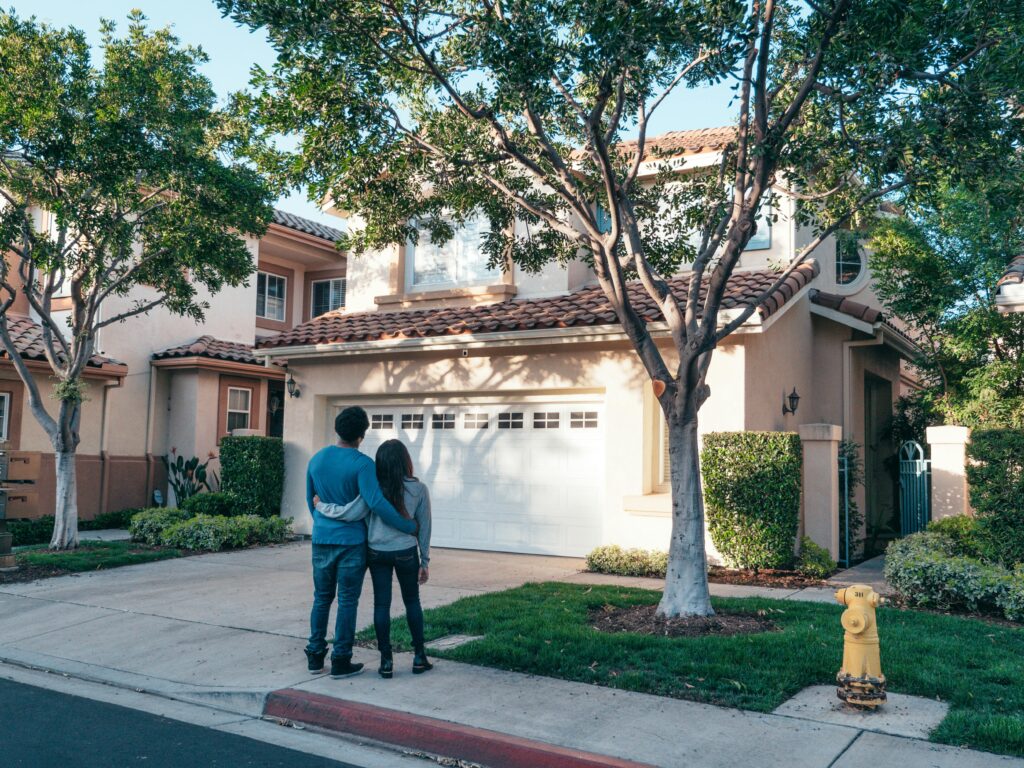
Our team has 50+ combined years of experience in the field of construction. With that being said, we are going to share our honest opinion on what the actual best garage door insulation is.
As we said above, the best option is to purchase a door that comes insulated. This is because you can obtain the best R-value possible.
We understand that prices have skyrocketed and unfortunately the price of insulated garage doors have doubled or tripled since 2008. It has put a massive strain on homeowner’s budgets, so we understand that you may need to cut back where you can.
If you currently have an uninsulated garage door or perhaps you have a shop or barn that needs insulation, the hands-down best insulation out there is professional grade spray foam. And yes, we recommend hiring the job out. In fact, it may be cheaper to have a professional do it versus attempting to do it yourself. With this type of insulation, you will get the best R-value and thermal barrier possible.
If spray foam is not an option, then we suggest you install rigid board in each panel of your garage. It will provide a good R-value and is user friendly with the help of a few youtube videos.
Garage Door Insulation Foam vs. Fiberglass-
We are going to keep this answer simple. Foam garage door insulation such as rigid board (blue/pink/yellow boards) far surpass fiberglass insulation. Take it from pros with over 50+ years of experience. Fiberglass insulation tends to have a lot of air pockets within its fibers which can result in a much lower R-value when compared to rigid foam boards. We suggest choosing rigid foam boards over fiberglass anyday.
Standard Garage Door Sizes-
We wanted to mention what you can expect for standard garage door sizes.
Here are the most common sizes:
Single Car Garage Door
- 8’ wide x 7’ high
- 56 square feet
Single Car Garage Door
- 9’ wide x 7’ high
- 63 square feet
Double Car Garage Door
- 16’ wide x 7’ high
- 112 square feet
Double Car Garage Door
- 16’ wide by 8’ high
- 128 square feet
Garage Door Insulation Price-
We talked about 5 different kit prices above. Listed below are the approximate prices for these kits. We will then discuss non-kit material pricing.
I want to preface that the listed prices are based upon the current market in 2025 and may change based on retailer, location, and availability.
Let’s jump in.
Garage Door Insulation Kit Pricing:
1. Reach Barrier 3009 Garage Door Insulation Kit
These kits may get you an R-Value of around 3-5 per square inch and cost you around $60-$90 for 8 panels (4×2 feet each)= 64 square feet total.
2. US Energy Products Double Bubble Reflective Foil
You can expect a double bubble reflective foil garage door insulation kit to get you an R-value of around 3 per square inch and cost you $40-60 per roll (1 roll typically will cover 500 square feet).
3. US Energy Products Nasatek 2-Car Foam Insulation Kit
This kit will get you an R-value of about 3.5-4.5 per square inch based upon the foam thickness and will cost about $120 (covers 18’x8’=144 square feet).
4. Matador Garage Door Insulation Kit
The Matador kit can get you an R-value of around 5-6 per square inch and will cost around $150 with materials to cover approximately 54″L x 20.25″W which is about 8 panels or 60.5 square feet.
5. Froth-Pak 620 Spray Foam Insulation Kit
Remember, this is a professional spray foam kit so it will be pricier than the other kits mentioned. It costs about $930. At 1 inch thick, it will cover approximately 650 square feet. At 2 inches thick, it will cover approximately 325 square feet. One kit will be plenty for your standard sized garage.
Common Pricing For Garage Door Insulation Kits Chart-
The chart above gives a rough estimate of what you can expect to pay for garage door insulation kits based upon your garage door size. These prices will vary based upon retailer, location, and availability.
Individual Material Pricing-
We decided to make it easy for you and create a chart that shows the cost of materials to insulate various garage door sizes. If you decide to DIY your garage door insulation without a kit, you may be interested in this chart to get a rough estimate of what your project will cost.
This chart does NOT include the price of tools and additional materials you may need beyond the insulation itself (for example, tape).
Garage Door Insulation Costs (Non Kit)
You will notice that you may save some money by choosing to buy materials individually. So, if you have the experience and know-how, it could be worth it for you to go this route.
Who Does Garage Door Insulation Do?
If you have decided that installing your own garage door insulation is not for you, where should you go?
You can definitely hire a professional insulation company.
If you live in the Twin Cities Metro Area, feel free to check out Atticus Insulation. Many of our clients have been happy with this company’s stellar work. You can also utilize an organization called Spray Foam Worldwide. This website can connect you with local insulation companies in your area.
Otherwise, grab a referral, make a post in your local facebook neighborhood group, or jump on a search engine to find your insulation contractor today.
How to Install Garage Door Insulation?
Installing garage door insulation will vary based upon the materials/kits you select and the garage style and size.
We could dedicate several blogs to going over how to actually install the material for each potential combo of options.
Here is a generalized version of how to install your garage door insulation. For specifics, follow the instructions on your kit, read the kit reviews and go on youtube to see what other people are doing.
Quick guide to install garage door insulation:
Materials:
- Insulation kit (choose your materials: reflective, rigid panels or foam)
- Measuring tape
- Utility knife/scissors
- Choose a strong adhesive/double sided tape (read kit reviews to determine if you need a different product than what is included in the kit…some adhesives included in the kits don’t work well.)
- Safety equipment like goggles and gloves
Steps:
1. Size out your garage door
- Measure the dimensions of your door in order to determine how much insulation you need. Depending on the size, you may need 1-2 kits.
2. Prepare the Garage Door
- Clean your garage door well to remove dust/debris/grease and remove any old insulation if necessary.
3. Cut the Insulation (if required)
- Measure and mark the insulation to fit your garage door (some kits will not require this). We recommend watching a few youtube videos on this.
- Cut the insulation to fit your panels (if needed. Some kits come pre-cut).
4. Install the Insulation
- For Reflective Foil Kits:
- Secure your insulation on the garage door panels with adhesive/double sided tape. Make sure you get a good product that will actually hold. Read the reviews on your kit before purchasing to see if homeowners recommended a different product than what was in the kit.
- For Foam or Rigid Panels:
- Fit the foam panels into each door section.
- Use adhesive or nails/screws based upon what the kit dictates.
- You can use adhesive to secure them or nails/screws (if the kit suggests it).
- For Professional Spray Foam (if using Froth-Pak): Note: We recommend hiring this out unless you are experienced working with this product.
5. Seal Edges (if necessary)
- Once the insulation is installed, you may need to seal any gaps around the edges using tape or a sealant.
6. Test the Door
- After installation, check the door to make sure it opens and closes without interference.
7. Enjoy Your Insulated Garage Door!
- The insulation should provide better temperature control and reduce noise and energy costs.
Well, there you have it. Your complete guide to garage door insulation, kits, panels and installation. If you have any additional questions about whether garage door insulation is right for you, please reach out at 763-544-3355.
